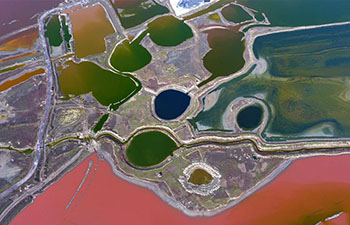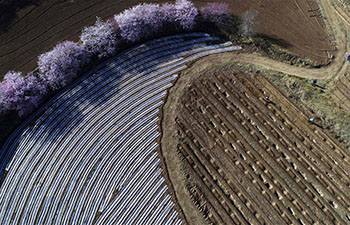WASHINGTON, April 13 (Xinhua) -- A home appliance that collects water from the air, even in dry or desert climates, using only the power of the sun, might be just around the corner.
In a study published Thursday in the U.S. journal Science, researchers from the Massachusetts Institute of Technology (MIT) and the University of California, Berkeley (UC Berkeley), described a prototype device that uses only ambient sunlight to pull liters of water out of the air each day in conditions as low as 20 percent humidity, a level common in arid areas.
"This is a major breakthrough in the long-standing challenge of harvesting water from the air at low humidity," said Omar Yaghi, one of two senior authors of the paper, who holds the James and Neeltje Tretter chair in chemistry at UC Berkeley and is a faculty scientist at the Lawrence Berkeley National Laboratory.
"There is no other way to do that right now, except by using extra energy. Your electric dehumidifier at home 'produces' very expensive water."
The solar-powered harvester was constructed using a porous material called a metal-organic framework (MOF)
-- a combination of zirconium metal and adipic acid -- that binds water vapor.
The resulting system consisted of more than two pounds of dust-sized MOF crystals compressed between a solar absorber and a condenser plate, placed inside a chamber open to the air.
Once water vapor is adsorbed into the material, solar energy heats up and then releases it to the condenser, where the vapor condenses as liquid water and drips into a collector.
Under conditions of 20 to 30 percent humidity, the prototype was able to harvest 2.8 liters of water over a 12-hour period, using one kilogram of MOF, the researchers said.
"This work offers a new way to harvest water from air that does not require high relative humidity conditions and is much more energy efficient than other existing technologies," said Evelyn Wang, a mechanical engineer at MIT, who designed the device with her students.
The researchers are at work improving their MOF materials and the harvesting system.
The current MOF can absorb only 20 percent of its weight in water, but other MOF materials could possibly absorb 40 percent or more.
The material can also be tweaked to be more effective at higher or lower humidity levels.
"We wanted to demonstrate that if you are cut off somewhere in the desert, you could survive because of this device," Yaghi said.
"A person needs about a Coke can of water per day. That is something one could collect in less than an hour with this system," he said.

















